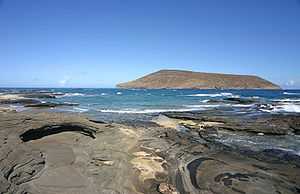Lehua



Lehua is a small, crescent-shaped island in the Hawaiian islands, only 0.7 miles (1.1 km) north of Niʻihau, due west of Kauai. The uninhabited, 284-acre (1.15 km2) barren island is a tuff cone which is part of the extinct Niʻihau volcano.
Lehua was one of the first five islands sighted by Captain James Cook in 1778 which he spelled as "Oreehoua".
Lehua Island is a Hawaii State Seabird Sanctuary. As a sanctuary, many activities are prohibited on the island, but entry is not prohibited. Lehua provides habitat for at least 16 species of seabirds, as well as some non-native rats and European Rabbits.
When weather and wave conditions permit crossings from Kauai, Lehua is a noted destination for snorkeling and scuba diving. It is also well known for an unusual geological formation dubbed "the keyhole". Located in one of the crescent's narrow arms, this is a tall, thin notch cut from one side, all the way through to the other side of the arm.
The United States Coast Guard maintains Lehua Rock Light (a lighthouse) on Kaunuakalā, at 704 feet (215 m) the highest point of the island.
References
- Hawaii Department of Land and Natural Resources. (30 March 1981). Rules Regulating Wildlife Sanctuaries (PDF). In, Hawaii Administrative Rules, § 13-125.
- Hawaiian Volcano Observatory. (29 September 1995). "Oʻahu, Niʻihau, and Kauaʻi". Volcano Watch.
- Light List, Volumes 1-7. United States Coast Guard. 2005.
- Lehua Island Ecosystem Restoration Project
| |||||||||||||||||
Coordinates: 22°01′12″N 160°05′51″W / 22.02000°N 160.09750°W

